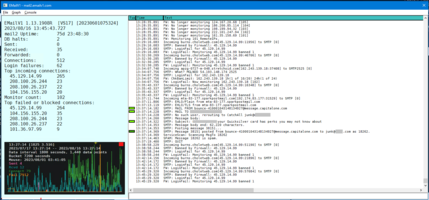

NYTimes: Everyone Wants Your Email Address. Think Twice Before Sharing It.
The solution is an infinite supply of throw-away addresses.
Happiness is building your own email server ...
It is perfectly fine to use a single email server to handle many domains. However, I need to be aware:
Why did I feel the need to write my own email server when there are already so many well-established programs available, many for free?
I tried using sendmail on a Linux system. This works, of course, and is by far the most common solution. But I am not familiar enough with Linux as a system admin and was never really sure it was working properly. Sendmail gives little feedback about what it is doing, and I could never get it to do exactly what I wanted. What I really wanted was a live display showing exactly what the server was doing right now that I could watch in real-time. Monitoring text logs was not good enough and they didn't contain exactly what I wanted.
I used MailEnable on Windows for a while, almost four years. This was reasonably priced ($130 one-time cost) and I was more comfortable managing Windows than Linux. MailEnable had some weird quirks, especially in the way it used separate services for SMTP, POP, and MTA. I had a bad experience where I accidentally set up an open relay (something no modern email server should ever enable) and did not realize it was spewing spam until my IP address was blacklisted. MailEnable would occasionally stop working for unknown reasons and need to be restarted every few months. The final straw was when the server became unresponsive because MailEnable had completely filled the disk with log files during a sustained DDoS attack. This was especially frustrating because MailEnable's logs are useless; they contain useless minutae in multiple formats without any sense of context. I could not make heads or tails of any of it. To keep MailEnable running, I would have to periodically log into the server and delete gigabytes of these useless logs.
Almost all existing email servers were written at a time when the biggest threat was spam and virus attachments. Today these are mostly solved problems, and the biggest problems are hackers who try to overwhelm a server with socket storms or suborn it with password guessers.
When I had to rebuild my email server yet again, I wondered just how hard would it be to write my own email server -- one that would do exactly what I wanted, use very little system resources, and be built from the ground up to resist hacker and DDoS attacks. I wanted an email server that was fully integrated with the firewall. I also wanted an email server that would use MySQL for data so that I could integrate with other stand-alone programs and easily monitor the status of the system.
EMailV1 is different than most existing email servers:
I found that writing a basic email server was not terribly difficult. Then it took a lot of trial and error to make it to work right, handle TLS connections, shrug off hackers, and interoperate with all existing email servers. I have now been using EMailV1 as my primary email server since July 2020, over three years now, and it has matured into a rock-solid service.
Comments are moderated. Anonymous comments are not visible to others until moderated. Comments are owned by the author but may be removed or reused (but not modified) by this site at any time without notice.